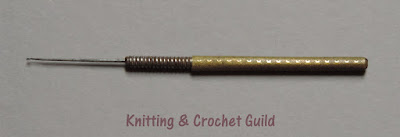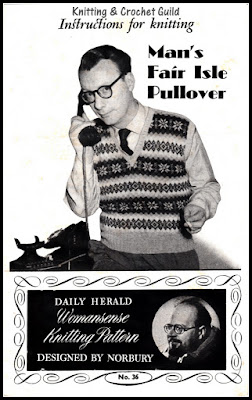And last week, at our usual Thursday morning knitting session, a friend brought several things to give to the collection, including these 15 crochet hooks. In case you think they look interesting too, I've written about some of them below.
Many of these hooks are late 19th or early 20th century - I've been looking at Nancy Nehring's website here, which gives a lot of information on the history of crochet hooks.
First is a 19th century hook (rather rusty, as early steel hooks are liable to be). It has a patent number (4439) on the sheath. I can't trace the patent, though Nancy Nehring dates it to 1888. I imagine that the patent was for the idea of including a tubular sheath (top) that can fit over the hook to protect it, when it is not being used, and otherwise can fit over the other end to form a handle.
Another early hook also has a tubular sheath - brass in this case. There are two hooks of different sizes, and the sheath can fit over either to form a handle. Nehring attributes this hook to John Shrimpton and Son (here).
In the next one, the hook is attached to a flower-shaped slider so that it can be retracted into the handle. (But there is nothing to hold the slider in place, when the hook is in use, so this may not have been a very successful design in practice.)
The next, with a handle made from a loop of wire, is hook by another Shrimpton, Z Shrimpton & Co. It has two hooks of different sizes, that can pivot in the middle. The brass slider can be moved (to the left, in the photo) to hold the hook that's not being used within the handle.
And here are two later hooks - the design was patented in 1911. They look identical, but one is called the "Evelyne" and the other the "Eclipse". They are like a flattened version of the first hook I described - there is a sheath that either fits over the hook (top), or can form a handle (bottom). By this time, the idea of having a flattened grip had been introduced, and very quickly seems to have become almost universal for metal crochet hooks.
There are three hooks in the donation that aren't steel. Two are bone, and the same design. One of them is marked 'Bates' - an American company that still makes crochet hooks. I think the different coloured ends are to show at a glance the size of the hook (at least once you know that dark blue means size 1 and light blue means size 5).
And finally, I think that the hook below might be ivory. It is a very uniform colour, whereas bone tends to develop brown marks with age, and it feels much smoother and denser than the bone hooks.
Altogether, it's a diverse and fascinating collection, just by itself. Thanks very much, Debbie.
















